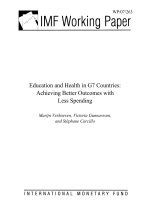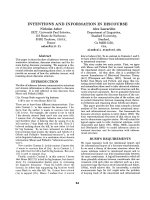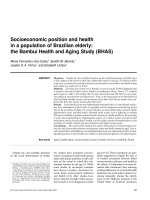Gender and Health in Disasters docx
Bạn đang xem bản rút gọn của tài liệu. Xem và tải ngay bản đầy đủ của tài liệu tại đây (729.34 KB, 4 trang )
Gender and
Health in Disasters
T
here is a general lack of research on sex and gender diff erences in vulnerability
to and impact of disasters. The limited information available from small scale
studies suggests that there is a pattern of gender diff erentiation at all levels of the
disaster process: exposure to risk, risk perception, preparedness, response, physical
impact, psychological impact, recovery and reconstruction.
July 2002
Globally, approximately 2 billion people were aff ected
by natural or technological disasters between 1990–1999,
with almost 600 000 fatalities
a
. More than 86% of peo-
ple killed by disasters during this period succumbed to
natural events. Windstorms claimed the largest propor-
tion of lives (35%) while fl oods accounted for the largest
proportion of people aff ected (75%).
Since the mid-1990s there has been an increase in the
recorded number of all types of disasters and the number
of recorded fatalities resulting from disasters, especially
in developing areas and despite disaster preparedness
programmes. People in low-income countries are 4 times
more likely to die from extreme natural events than those
in high-income countries. During the 1990s, more than
two-thirds of the deaths from disasters occurred in
Asia, which was also the continent most frequently hit
by disasters
b
.
Although human-made technological disasters report-
edly claim fewer lives than natural disasters (13.5% during
1990-99), they have profound implications for public
health. For example, about 5 million people, including
500 000 children, are estimated to have been aff ected by
the Chernobyl nuclear disaster in 1986. Nearly a decade
and a half later, there continues to be a large case load of
health problems linked to the Chernobyl disaster. Many
of the survivors of the 1984 Bhopal industrial disaster
have suff ered respiratory damage or are aff ected by re-
peated infections because of compromised immune or
metabolic systems.
What do we know?
Exposure and vulnerability throughout the
disaster process
Interaction of biological and social risk factors
There is some evidence showing that women and men
may suff er diff erent negative health consequences fol-
lowing a disaster. It is not clear whether this is because
of biological diff erences between the sexes, because of
socially determined diff erences in women’s and men’s
a. Figures do not include public health disasters such as the AIDS
pandemic or other epidemics as per CRED (the Center for Research
on the Epidemiology of Disasters) and EM-DAT statistics as quoted by
ICRC World Disasters Report 2000.
b.Excluding confl ict and chronic health disasters as per CRED and EM-
DAT fi gures as cited by ICRC World Disasters Report 2000.
c.Human confl icts which give rise to complex emergencies are beyond the
scope of this information sheet. A forthcoming information sheet will
specifi cally address gender and health issues in complex emergencies.
! Disaster is a diffi cult concept to defi ne; existing defi nitions tend to be
either too broad or too narrow. The World Health Organization/Emergency
and Humanitarian Action Department defi nes disasters as, “Any occur-
rence that causes damage, ecological disruption, loss of human life or
deterioration of health and health services on a scale suffi cient to warrant
an extraordinary response from outside the affected community area.”
! Disasters are classifi ed as human-made (non-natural) and natural.
! Natural disasters are environmental events, not (directly) human made,
such as volcanic eruptions, earthquakes, fl oods, cyclones or more long term,
epidemics, drought, famine (catastrophic food shortage).
! Human-made or technological disasters are primarily caused by
hardware failure and human error resulting in toxic emissions, for example
explosions and transport accidents onsetting a chemical spill, leading to
insidious air, water and soil pollution and food contamination.
Defi nitions
c
roles and status or because of an interaction of social
and biological factors.
• In 1976 an accident in a chemical plant near Seveso,
Italy, exposed the local population to dioxin. A
twenty-year follow-up study which compared those
in exposure zones with a reference population in a
surrounding non-contaminated area found that fi fteen
years after the accident, mortality from rectal cancer
and lung cancer increased among men in high-expo-
sure zones. An overall increase in diabetes mortality
as compared to those living in the non-contaminated
area was reported, notably among women.
Studies have also reported adverse reproductive out-
comes following disasters, including early pregnancy
loss, premature delivery, stillbirths, delivery-related
complications and infertility.
• A study from Israel reported an increase in delivery
rates during the 48 hours following an earthquake and
a signifi cant increase in the premature delivery rate.
• In India, 24% of pregnant women exposed to isocya-
nide during the 1984 Bhopal explosion had spontaneous
abortions, as against 6% in a comparison group.
Social taboos around menstruation and norms about ap-
propriate behaviour for women and girls are reported
to contribute to health problems in young women in
disaster situations.
• During the 1998 fl oods in Bangladesh, adolescent girls
reported perineal rashes and urinary tract infections
because they were not able to wash out menstrual rags
properly in private, often had no place to hang the rags
to dry, or access to clean water. They reported wearing
the still damp cloths, as they did not have a place to
dry them.
Gender roles
Women’s vulnerability to the impact of disasters is also
increased by socially determined dif-
ferences in roles and responsibilities
of women and men and inequalities
between them in access to resources
and decision-making power.
• Excess deaths among females
following an earthquake in
Maharashtra, India were attributed
to women being in homes damaged
by the earthquake and men being
in open areas. Men were sleeping in
fi elds during harvest time and were
away from the home in preparation
for a festival, boys were at school
away from the village, and many
men were away from aff ected ar-
eas as they were employed in other
districts or states.
• One study on a 1991 cyclone in Bangladesh noted that
many women perished with their children at home as
they had to wait for their husbands to return and make
an evacuation decision.
When compounded by a calamity, the comparatively
lower value ascribed to girls in some societies may take
on lethal manifestations. One report from Bangladesh
describes a father who, when unable to hold on to both
his son and his daughter from being swept away by a tidal
surge, helplessly released his daughter, because “… (this)
son has to carry on the family line”.
Men, on the other hand, may suff er other disadvantages
in diff erent situations and for diff erent reasons from
women, because of their gender-role socialization.
• Field notes from a Western Ethiopian refugee camp
report an instance where young Sudanese men fl eeing
conscription continued to starve in refugee camps de-
spite receiving prompt shipment of food aid. The food
they were given needed to be cooked before it could be
eaten, and as men, they had never learned to cook.
• Researchers reported that in the aftermath of Hurricane
Andrew in the United States of America, men who had
traditionally been the family providers and protectors
struggled with their feelings of inadequacy and failure.
Men’s roles as protectors may place a greater responsi-
bility on them for risk taking during and after a disaster,
both within their households and as volunteers and
rescue workers. The vast majority of the 800 000 plus
‘liquidators’ – soldiers and civilians who helped clean up
the Chernobyl site over several years, and were most
exposed to the radiation – were men.
Perception of risk and access to relief services
Gender diff erences may exist in the perception of hazard
risks. It has been suggested that women perceive disaster
events or threats as more serious and risky than men do,
especially if they threaten their family members.
Traditional gender roles are also played out in the
response phase of disaster situations. In a study on hur-
ricane Andrew in the US, women were responsible for
caring for family members, stocking supplies and pre-
paring the household while men were responsible for
securing external areas of the house. Following a fl ood,
one researcher observed that while men would build
roads and houses the role of putting lives back together
was the women’s.
Diff erences are also reported around post-disaster re-
lief. Cultural norms have been found to inhibit women
from visibly accessing relief centres, or they cannot leave
their homes to go to relief centres due to child care re-
sponsibilities. In settings where women are forbidden to
interact with male members of the community who are
not their kin, they may have diffi culties in accessing relief
services from male relief workers. Further, where food
distribution targets household heads, women may be sys-
tematically marginalized, as they would only be registered
as household heads if no adult male was present.
Impact of disasters
The impact of disasters is felt diff erentially within socie-
ties, and those most socially excluded and economically
insecure bear a disproportionate burden. The impact of
disasters also varies between women and men.
Social and economic consequences
Loss of the ability to take care of the family may cause
adjustment diffi culties for some men, especially those
with more traditional gender role norms. Others may
view receiving fi nancial aid as a stigma and feel challenged
in their role as breadwinner.
Women may fi nd themselves burdened with even
greater responsibilities than before. Post disaster “fl ight
of men” often occurs, leaving women as sole earners. This
phenomenon has been observed in Miami, rural Bangla-
desh, the Caribbean, and Brazil where it is reported that
men abandoned women and families and used relief aid
for themselves.
At the same time, lower literacy levels and very low
levels of ownership of land and other productive assets
may leave women on the verge of destitution.
• One study reports instances of women in Bangladesh
becoming destitute following a disaster as male rela-
tives confi scated family land from a woman in the event
of her husband’s and son’s deaths, leaving women and
daughters poverty stricken and destitute. There were
no legal provisions to protect women and their families
against such problems.
Domestic and sexual violence
Although hard evidence on the infl uence of disasters
on domestic and sexual violence is limited, several fi eld
reports suggest that the safety of women experiencing
violence in the home may be compromised in the after-
math of disaster and they may not have access to disaster
relief and recovery resources. These women often live in
a world of narrow social networks. Attending to prepar-
edness or evacuation warnings, stabilising their lives in a
disaster-stricken neighbourhood, or accessing recovery
resources may be impossible tasks.
• Following a major Australian fl ood in 1990, one ob-
server noted that women experiencing violence in
the home, who were socially isolated, became even
more isolated and there was an increase in domestic
violence.
• After the 1989 Loma Prieta earthquake, the director
of a battered women’s shelter in Santa Cruz, USA
reported a 50% increase in requests for temporary
restraining orders.
• According to reports from a community intervention
centre in the US, women left without housing in a
post-disaster situation called the perpetrator of the
violence, seeking accommodation.
Women and girls are more vulnerable to sexual abuse
in disaster situations and may be coerced into sex for
basic needs such as food, shelter and security. The sex
industry often becomes part of the interaction between
the refugee or displaced population and the local com-
munity. Men and boys may also be at risk of sexual abuse
in such circumstances.
Psychological impact
Psychological responses to disasters include short term
eff ects such as shock, anxiety, sleep disturbances and
guilt. There are diff erences between women and men
and girls and boys in the nature of psychological impact.
Several studies have found that a greater proportion of
women and girls report suff ering from emotional disor-
ders and distress as compared to men and boys.
• Female sex, lower social support and being older were
associated with higher post-disaster psychological dis-
tress after the 1989 Australian earthquake.
• A survey of children aff ected by the 1995 Great Han-
shin Awaji earthquake showed that girls were more
heavily aff ected by trauma and that being female was
a high risk factor for distress.
Women’s dramatically expanded caregiving roles follow-
ing a disaster, and putting family needs before their own,
may explain overall declines in emotional well being.
Issues in planning and delivery of relief services
Emergency management agencies and others responsible
for emergency relief such as law-enforcement agencies
and fi re personnel have historically been dominated by
WORLD HEALTH ORGANIZATION
Department of Gender and Women’s Health
20, Avenue Appia
Geneva, Switzerland
men. Male-dominated recovery groups which see disas-
ters ‘through the eyes of men’ may organize relief work
in a manner that does not take gender diff erences and
women’s specifi c needs into consideration. For example,
sanitary napkins, contraceptives and counselling services
for psychological distress and domestic violence are rarely
available in emergency situations.
There is also a tendency on the part of relief planners
to take for granted women’s time and labour for work as
paid and unpaid care givers in the aftermath of a disaster.
Similarly, they may assume men’s physical and emotional
strength, and therefore overlook their needs.
What research is needed?
" There is urgent need for international data sets to
provide sex-disaggregated data on disaster-related mor-
tality, morbidity and long-term health consequences.
" At the local level, there needs to be better documenta-
tion of:
– whether and how perceptions, preparedness and warning
response in disaster relief and vulnerability are infl uenced
by gender-based diff erences between women and men;
– how gender relations operate in households and com-
munities in a disaster situation and during the relief
and recovery phase; and
– how gender roles and gender relations infl uence coping
mechanisms.
" Research is needed both at the local and at national
and regional levels on structural processes and factors
that increase disaster vulnerability in women and men
across diff erent social groups.
" Domestic and sexual violence in the aftermath of a
disaster and the special needs of disadvantaged women,
such as women with disabilities and women in violent
relationships needs to be better researched.
" Gender relations in disaster organizations, eff ects of
gendered organizational culture on staffi ng, funding,
programming, training; and the consequences of these
for women and men in disaster situations is another
important area that needs to be addressed by research
studies.
" Evaluation studies of recovery and mitigation pro-
grammes are needed to assess eff ectiveness of diff erent
strategies which incorporate gender equity and social
justice into disaster mitigation and reconstruction.
What are the implications for
disaster relief programmes and
policies?
" Pre-disaster activities such as hazard mapping and
vulnerability analysis should integrate gender consid-
erations. At a minimum, this would involve taking
into account:
– the diff erences in vulnerability to and impact of disasters
in women and men; and
– how their roles and status affect disaster-relief and
recovery.
" Community-based disaster-preparedness projects and
disaster training and education programmes should
include women and men, and address their respective
needs and concerns.
" Information collected through rapid assessments of
health status and health needs in disaster situations
should be sex-disaggregated and include a gender
analysis. Information is needed on reproductive and
mental health needs, in addition to information on
communicable diseases and on malnutrition.
" Basic health services provided as part of emergency
relief should likewise cater to women’s and men’s
diff erent needs and be provided in a gender-sensitive
manner.
" Disadvantaged groups such as women and men with
disabilities and women in violent relationships should
be identifi ed as special-risk populations for disaster re-
lief and recovery services. It may be useful to work with
community organizations to identify these groups.
" Gender training of emergency managers and health
service providers should become an integral part of
staff training in all organizations and agencies involved
in disaster-relief.
" The initiative for gender mainstreaming the Coordi-
nated Appeals Process (CAP), a tool for United Na-
tions coordination and programming for humanitarian
assistance at the international level, needs to conscious-
ly address health issues from a gender perspective.
© World Health Organization, 2002
All rights reserved









